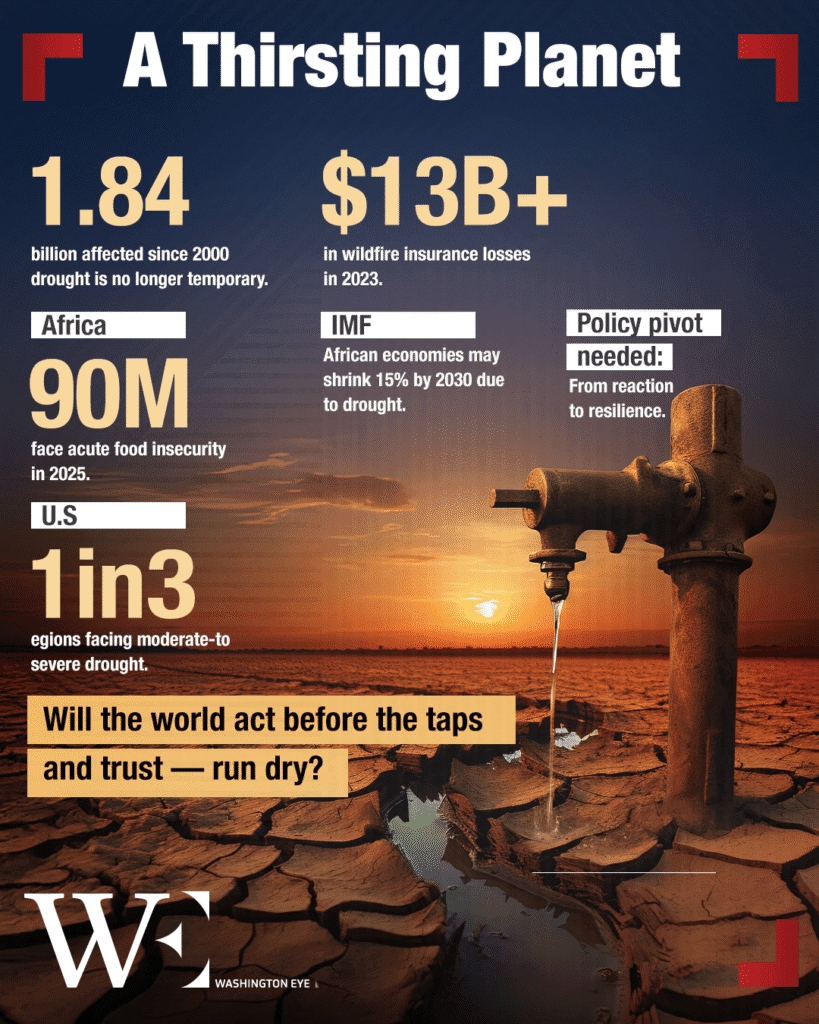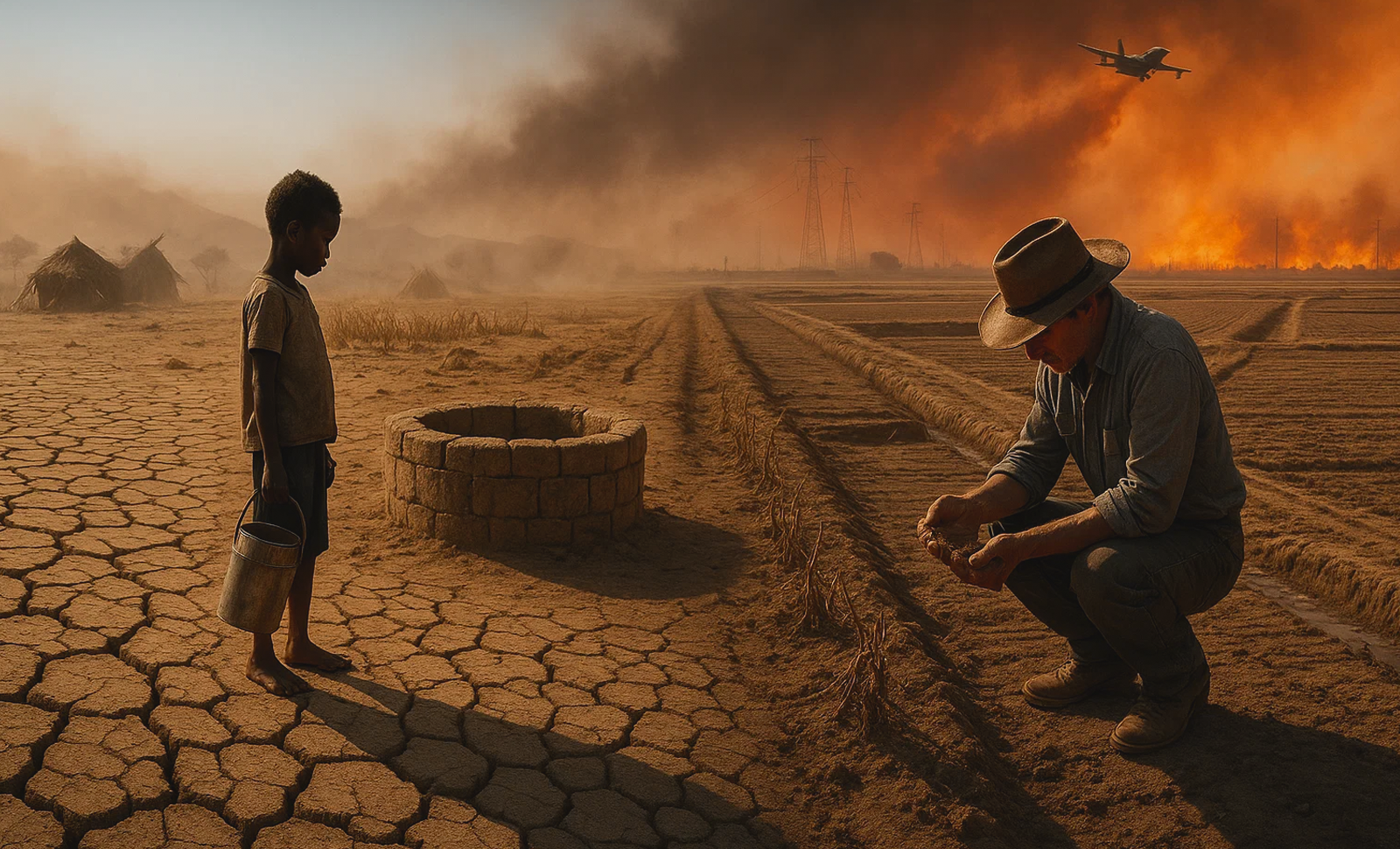From Southern Africa to Central America, climate-induced drought is no longer a cyclical hardship—it is becoming the defining crisis of the 21st century. With more than 1.84 billion people affected globally since 2000, according to the UN Convention to Combat Desertification, drought is rapidly transforming into a permanent disruptor of food systems, water supplies, public health, and geopolitical stability. What was once seen as a localized, weather-driven challenge is now evolving into a complex, systemic threat—one with implications for global power structures, economic resilience, and humanitarian obligations.
Nowhere is this transformation more visible than in Africa, where the confluence of El Niño patterns, climate change, and governance gaps has triggered what the UN calls “a rapidly worsening disaster”, according to the United Nations. But the reverberations extend far beyond the continent—and the United States is not immune.
Africa’s Humanitarian Emergency: A Window into the Future
In 2024–2025 alone, over 90 million people across Eastern and Southern Africa experienced acute food insecurity, with harvest failures, livestock deaths, and water shortages cascading across national borders, according to The Guardian. In Somalia, UNICEF estimates that over 43,000 people—nearly half of them children—died in 2022 due to drought-related causes. This trend has only deepened, as rural economies collapse and displacement surges across the Horn of Africa.
Such losses are not mere tragedies—they represent a breakdown of state capacity and a warning about what happens when climate shocks overwhelm basic infrastructure. Health systems buckle under the weight of rising malnutrition and disease; energy systems falter as hydroelectric reservoirs dry; and political tensions flare as competition over dwindling resources intensifies.
Importantly, this isn’t just about a single region. Africa, while disproportionately affected, is acting as an early indicator of a more widespread fragility in the face of sustained climate stress.
Climate Volatility and the U.S: An Emerging Risk Frontier
While the scale of suffering in Africa remains the most urgent concern, the United States faces its own set of challenges under the shadow of intensifying drought. A 2024 report from the National Integrated Drought Information System (NIDIS) showed that nearly one-third of the U.S. experienced moderate to severe drought conditions, affecting major agricultural states like California, Kansas, and Texas.
In California’s Central Valley—one of the world’s most productive food regions—drought has reduced surface water deliveries by up to 80% in recent years, prompting fallowed fields and increased groundwater pumping. The consequences ripple outward: food prices rise, labor markets in farm communities destabilize, and aquifers—some of which take centuries to recharge—are depleted at unsustainable rates.
Moreover, the growing link between drought and wildfires poses an existential threat to both ecosystems and the insurance industry. In 2023 alone, insured losses from climate-driven wildfires in the U.S. exceeded $13 billion—an amount that could double if current precipitation trends continue.
These conditions demand a new policy calculus in Washington. While climate legislation like the Inflation Reduction Act provides historic investments in clean energy, experts warn that drought resilience—through watershed restoration, improved irrigation, and reformed water markets—remains underfunded and fragmented across jurisdictions.
The Economic Cascade: Why Drought Is a Global Market Risk
Drought doesn’t only disrupt crops and communities—it destabilizes economies. In sub-Saharan Africa, agriculture employs nearly 60% of the population and constitutes over 30% of GDP in some nations. When rainfall fails, so do livelihoods, tax revenues, and the export base. The International Monetary Fund estimates that climate-related shocks could shrink African economies by up to 15% by 2030 without robust adaptation investments.
The ripple effects are already reaching global markets. As regional food systems collapse, international aid burdens increase, supply chains falter, and commodity prices spike. For the U.S., this spells not only humanitarian responsibility, but economic exposure—from volatile grain markets to heightened migration pressures at its borders.
A 2025 World Bank assessment suggests that water scarcity could cost some nations up to 6% of their GDP by mid-century, unless water governance dramatically improves. For countries like the U.S., with major agricultural export stakes, global drought threatens both profits and political alliances.
Policy Futures: Toward Climate-Integrated Governance
The growing permanence of drought requires a shift from reactive disaster relief to proactive systems change. Experts call for three core strategies: regional water-sharing frameworks, climate-resilient infrastructure, and robust social safety nets to buffer vulnerable populations.
In the U.S., pilot programs like California’s Sustainable Groundwater Management Act (SGMA) represent early steps toward smarter water use—but broader federal coordination and investment are needed. Similarly, international drought insurance mechanisms and anticipatory aid financing—like those piloted in Kenya and Ethiopia with World Bank support—could inform U.S. engagement abroad.
At the multilateral level, the Global Framework on Water Scarcity in Agriculture (WASAG), hosted by the FAO, is advancing cross-sectoral solutions for water-stressed regions. But participation from high-income countries, including the U.S., remains inconsistent, highlighting a missed opportunity for leadership on an increasingly borderless issue.
A Final Note: Drought as a Global Test of Governance
What the current crisis reveals is not just a failure of rainfall—but a failure of foresight. As drought intensifies in duration, scale, and complexity, it demands a recalibration of what constitutes national security, global stability, and economic planning.
Africa may be the most visible front line today, but the pressures are planetary. The U.S.—a global agricultural power, humanitarian actor, and climate influencer—has the tools and the responsibility to lead on adaptation and resilience. Whether it chooses to do so, or waits until its own water tables run dry, will help define the legacy of this era.

















